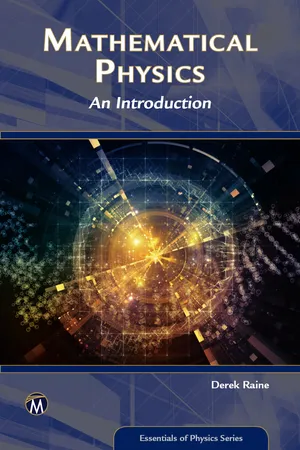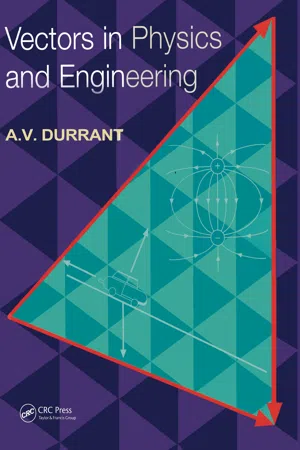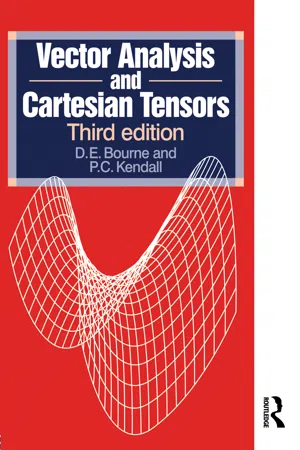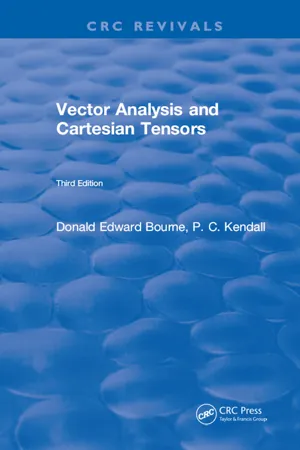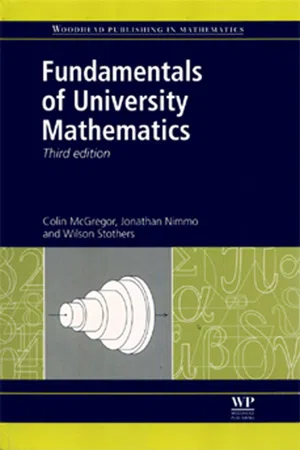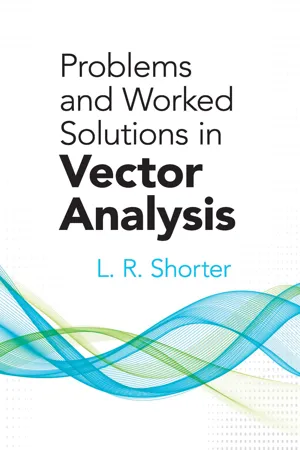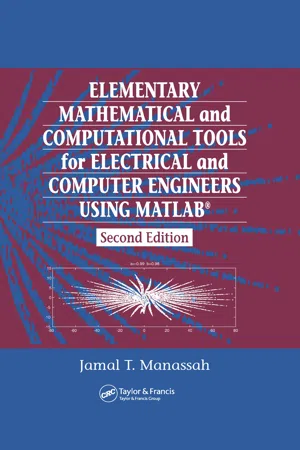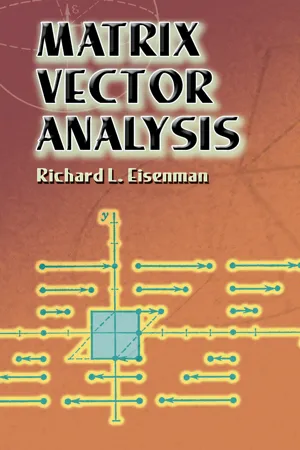Mathematics
Scalar Triple Product
The scalar triple product is a mathematical operation that takes three vectors and produces a scalar quantity. It is calculated by taking the dot product of one vector with the cross product of the other two vectors. Geometrically, the scalar triple product represents the volume of the parallelepiped formed by the three vectors.
Written by Perlego with AI-assistance
Related key terms
11 Key excerpts on "Scalar Triple Product"
- Keith C Brown(Author)
- 2020(Publication Date)
- Royal Society of Chemistry(Publisher)
vector triple product . The Scalar Triple Product is:·( × )in which the three vectors are non-coplanar. This is the formula for the volume of a parallelepiped whose sides are the three non-coplanar vectors,,and :V = ·( × )That this is so is evident from Figure 3.11 and the following argument. The volume of the parallelepiped is the area of the parallelogram defined by vectors and times the height, h , of the parallelepiped. The area of the base of the parallelepiped is:‖ × ‖=‖ ‖‖ ‖ sin (θ )that is, the magnitude of the cross product (see Appendix A). The vector defined by the cross product is the area vector and is orthogonal to the plane described by vectors and(see Figure 3.12 ).Figure 3.11 A parallelepiped defined by vectors , and .Figure 3.12 The area vector = × .We now are in a position to show that our assertion concerning the volume of the parallelepiped is true:In other words, the height, h , of the parallelepiped times the area defined by the base (not basis!) vectors of the parallelepiped. We may represent this result in determinant form:The proof of this uses the matrix notation for the inner product operations in the next section. We may also write the Scalar Triple Product as:( × )·which is equivalent to our first Scalar Triple Product:·(× )=( × )·That this is so follows from our geometrical arguments. If we define the base of the parallelepiped using vectors and then, as above, × is the area of the base and then the height of the parallelepiped is given by · .What if the result of the Scalar Triple Product is zero? This could be so if one or more of the vectors is the zero vector, however, this is trivial and of more interest is the situation in which all three vectors are coplanar and are therefore dependent vectors. Given our above geometrical arguments this would naturally be expected to give a zero volume for the parallelepiped.- eBook - ePub
Mathematical Physics
An Introduction
- Derek Raine(Author)
- 2018(Publication Date)
- Mercury Learning and Information(Publisher)
The introduction of a set of basis vectors provides the crucial link between the geometrical picture of a vector (an object with magnitude and direction) and the algebra of vectors (objects formed from linear combinations of the basis vectors). By passing between the two approaches we can formulate a problem in geometric terms, solve it using algebra and then return to a geometric picture, if that is appropriate. We shall see many examples of this in what follows: it is one of the reasons why vectors are so useful in physical science.4.3.THE SCALAR (DOT) PRODUCT
We have seen how to add vectors both geometrically and in terms of a basis, and we have seen how to multiply a vector by a scalar but so far we have given no meaning to multiplying vectors.We are free to choose a definition for the product of two vectors, but if the resulting construct is to have any use it must correspond to some geometrical operation on directed line segments. It turns out that there are two such operations. The first of these is called the scalar or “dot” product and is defined here. Later we shall meet another product called the vector product. These are the only two meaningful ways of multiplying vectors. (Actually there is another, called the tensor product, but that will not concernus here.)Definition: Let θ be the angle between the two vectors a and b . The scalar product (or “dot product”) of two vectors a and b , written a · b , is defined to be the number |a ||b | cos(θ ):Note that the definition implies the important resulta · a = |a |2 .Notice that the scalar product takes two vectors and produces one scalar (a number). Also notice, from the definition (Equation 4.5),that the scalar product is commutative:(the order of the two vectors in the scalar product does not affect the result).If is a vector of unit length making an angle θ with a vector v, thenis the (orthogonal) projection of v on (see Figure 4.4 ). In Section 4.9 we shall find an alternative expression for the projection of one vector on another that does not explicitly involve the angle θ - eBook - ePub
- Alan Durrant(Author)
- 2019(Publication Date)
- CRC Press(Publisher)
2Vector algebra II Scalar and vector products
Objectives After you have studied this chapter you should be able to- Use the geometric definition of the scalar product to calculate the scalar product of two given vectors (Objective 1 ).
- Use the scalar product to determine the projection of a vector onto another vector (Objective 2 ).
- Manipulate algebraic expressions involving the scalar product (Objective 3 ).
- Test two given vectors for orthogonality (Objective 4 ).
- Determine the scalar product of two cartesian vectors (Objective 5 ).
- Use the scalar product to determine the magnitude of a given vector and the angle between two given vectors (Objective 6 ).
- Use the geometric definition of the vector product to calculate the vector product of two given vectors (Objective 7 ).
- Use the vector product to determine the areas of parallelograms and triangles (Objective 8 ).
- Manipulate expressions containing vector products (Objective 9 ).
- Determine the vector product of two cartesian vectors (Objective 10 ).
- Use the vector product to test for collinear vectors (Objective 11 ).
- Recognise and calculate Scalar Triple Products and vector triple products of given vectors (Objective 12 ).
- Manipulate expressions involving triple products of vectors (Objective 13 ).
- Use scalar products and vector products in a scientific and engineering context (Objective 14 ).
Chapter 1 was concerned with multiplying a vector by a scalar (scaling) and the addition of vectors. This chapter is concerned with products of vectors. There are two useful ways in which a product can be formed from two vectors. One is called the scalar product because the product so formed is a scalar quantity; the other is called a vector product because the product is itself another vector. Both kinds of product have wide applications in science and technology, as well as in mathematics. We begin with the scalar product.2.1 The Scalar Product
The scalar product is associated with the idea of projection. An everyday example of projection is the shadow of a solid body cast on a flat surface by a source of light such as the Sun. This is an example of the projection of a solid body onto a plane. We are interested in the projection of one vector onto another vector. This is illustrated in Fig 2.1a which shows a vector a directed at an angle a from the direction of a vector b . The point P is obtained by dropping a perpendicular from the end point of a onto the line of b . The length OP = | a | cosα is the projection of vector a onto vector b . We often refer to this as the projection of a onto the direction of b or onto the unit vectorb ^. Note that the projection of a onto b depends on the direction but not the magnitude of b . The projection is a positive number when the angle a is an acute angle as in Fig 2. 1a ; it can be zero or negative as illustrated in Figs 2.1b and c - Rutherford Aris(Author)
- 2012(Publication Date)
- Dover Publications(Publisher)
c the simplest is the scalar product of one with the vector product of the other two. This is known as the triple scalar product(2.34.1)We observe that the vanishing of this is just the condition for coplanarity of a , b , and c , for this says that a is orthogonal to the normal to the plane of b and c and so in it. (Cf. Ex. 2.32.2). Physically it may be interpreted as the volume of the parallelepiped with sides a , b , and c for b ∧ c has magnitude equal to the area of one face and direction n normal to it and a · n is the height. Notice that an even permutation may be applied to a , b , and c without changing the triple scalar product but that an odd permutation will change its sign. The notation [a , b , c ] or (abc ) is sometimes used for the triple scalar product.2.35. Triple vector product
Another product may be formed from three vectors a ∧ (b ∧ c ). This is known as the triple vector product. Since b ∧ c is a vector normal to the plane of b and c and a /\ (b /\ c ) is a vector normal to b /\ c , the triple vector product must be in the plane of b and c and so can be expressed in the forma ∧ (b ∧ c ) = β b + γ c .In component notation this isε ijk a j ε klm b l c m = βb i + γc iHowever, by Ex. 2.32.1, and hence(2.35.1)Permuting the letters in this equation we have the identity(2.35.2)There are a number of other identities and extensions to products of a larger number of factors. Some of these are given as exercises and are valuable practice in these elementary manipulations.Exercise 2.35.1 . Show a · (b ∧ c ) vanishes identically if two of the three vectors are proportional to one another.Exercise 2.35.2 . If e is any unit vector and a an arbitrary vector show thata = (a · e )e + e ∧ (a ∧ e ).This shows that a can be resolved into a component parallel to and one perpendicular to an arbitrary direction e .Exercise 2.35.3 . Prove thatExercise 2.35.4 . Show that the two linesx = a + ls , x = b + m s ,where s is a parameter and I and m are two unit vectors, will intersect if a ∙ (l ∧ m ) = b · (I ∧ m ) and find their point of intersection.2.36. Reciprocal base systems
- P C Kendall(Author)
- 2017(Publication Date)
- Routledge(Publisher)
scalar λ, a × (λ b) = (λ a) × b = λ (a × b). 2.34 If a × b = a - b, prove that a = b. 2.35 Find the most general form for the vector u satisfying the equation u × (2, 1, - 1) = (1, 0, 0) × (2, 1, - 1). 2.36 Find a,. b if (a i + b j + k) × (2 i + 2 j + 3 k) = i − j. 2.37 By constructing an example, show that in general the associative law for vector products does not hold; that is, there exist a, b, c such that a × (b × c) ≠ (a × b) × c. 2.38 Prove vectorially that the medians of a triangle are concurrent. [ Hint. Let E, F, G be the mid-points of the sides BC, CA, AB of a triangle ABC. Let AE, BF meet at O and denote the position vectors of A, B, C relative to O by a, b, c. Find the position vectors of E and F, and deduce that a × (b + c) = 0 and b × (c + a) = 0. Hence show that c × (a + b) = 0 and deduce the result required.] 2.8 The Triple Scalar Product The scalar a. (b × c) is called a triple scalar product. If a = (a 1, a 2, a 3), b = (b 1, b 2, b 3), c = (c 1, c 2, c 3) we have Thus It is easily verified that a. (b × c) = (a × b). c, (2.32) that is, the ′dot′ and ′cross′ may be interchanged in a triple scalar product. Geometrical interpretation Consider the parallelepiped with adjacent edges representing vectors a, b, c, as shown in Fig. 2.16, with b and c horizontal. The volume V of the parallelepiped is ‘area of base × height’. That is V = | (b c sin θ) (a cos ϕ) |, where θ is the angle between b and c and φ is the angle between a and the upward vertical. But b × c = b c sin θ k, where k is a unit vector vertically upwards. Also a. k = a cos ϕ. It follows that V = | a. (b × c) |. (2.33) Condition for coplanar vectors Three non-zero vectors a, b, c are coplanar if and only if a. (b × c) = 0. Proof As the three vectors have non-vanishing magnitudes, the volume V of a parallelepiped with adjacent edges a, b, c is zero if and only if the vectors are coplanar. Thus (2.33) shows that a, b, c are coplanar if and only if a- eBook - ePub
Vector Analysis and Cartesian Tensors
Third Edition
- Donald Edward Bourne(Author)
- 2018(Publication Date)
- Chapman and Hall/CRC(Publisher)
interchanged in a triple scalar product. Geometrical interpretation Consider the parallelepiped with adjacent edges representing vectors a, b, c, as shown in Fig. 2.16, with b and c horizontal. The volume V of the parallelepiped is ‘area of base × height’. That is V = | (bc sin θ) (a cos φ) |, where θ is the angle between b and c and φ is the angle between a and the upward vertical. But b × c = bc sin θ k, where k is a unit vector vertically upwards. Also a. k = a cos φ. It follows that V = | a. (b × c) |. (2.33) Condition for coplanar vectors Three non-zero vectors a, b, c are coplanar if and only if a. (b × c) = 0. Proof As the three vectors have non-vanishing magnitudes, the volume V of a parallelepiped with adjacent edges a, b, c is zero if and only if the vectors are coplanar. Thus (2.33) shows that a, b, c are coplanar if and only if a. (b × c) − 0. Note The triple scalar product a. (b × c) vanishes if any two of the three vectors are parallel or anti-parallel, but the converse of this statement is not true. Fig. 2.16 The volume of a parallelepiped is a. (b × c). EXAMPLE 5 If the non-zero vectors a, b, c are not coplanar show that any other vector A may be expressed uniquely in the form A = λ a + μ b + v c, where λ, μ, v are scalars. Solution Let A = (A 1, A 2, A 3), a = (a 1, a 2, a 3), b = (b 1, b 2, b 3), c = (c 1, c 2, c 3). Then A = λ a + μ b + v c, if and only if A 1 = λ a 1 + μ b 1 + v c 1, A 2 = λ a 2 + μ b 2 + v c 2, A 3 = λ a 3 + μ b 3 + v c 3. These simultaneous equations for λ, μ, v have a unique solution if and only. if | a 1 a 2 a 3 b 1 b 2 b 3 c 1 c 2 c 3 | ≠ 0, i.e. a. (b × c) ≠ 0. This condition is satisfied because a, b, c are not coplanar and are non-zero, and so the required result follows. EXERCISES 2.39 By writing out components, or otherwise, prove that a - eBook - ePub
- Colin McGregor, Jonathan Nimmo, Wilson Stothers(Authors)
- 2010(Publication Date)
- Woodhead Publishing(Publisher)
Chapter 13Products of Vectors
In Chapter 12 , we saw that vectors can be used to study points and lines in three dimensional space. Another fundamental concept in geometry that was not considered there is angle . In this chapter we define the angle between vectors. In connection with this we introduce the scalar product of vectors.We also study a second product, the vector product . Both products have many properties which resemble those familiar properties of the product of real numbers. However the vector product is not commutative.Whereas the scalar product is often used to compute angles, one purpose of the vector product is to construct a vector perpendicular to two given vectors. This property is used in solving problems related to planes and spheres.We also study triple products in which the two types of product are combined and we consider both their mathematical properties and some of their applications.13.1 Angles and the Scalar Product
Definitions 13.1.1 Suppose that u and v are non-zero vectors. The angle between u and v is the angle in [0, π] between any representations of the vectors. The angle between a vector and the zero vector is not defined.We say that non-zero vectors are perpendicular if the angle between them is π/2. If u and v are perpendicular then we sometimes write u v.Observe that the angle between v and u is the same as the angle between u and v, i.e. no ‘sense’ is attached to the angle.Remark Consider non-zero vectors u and v. Let and both represent u, and let and both represent v as shown in Figure 13.1.1 . Then and both represent v – u. It follows that ΔABC and ΔPQR are congruent since their corresponding sides are of equal length. Hence ∠ BAC = ∠ QPR = θ ∈ [0, π],Figure 13.1.1This shows that the angle between the vectors u and v is independent of the choice of representation.Theorem 13.1.2 Let u and v be parallel, non-zero vectors. Then the angle between - eBook - ePub
- L.R. Shorter(Author)
- 2014(Publication Date)
- Dover Publications(Publisher)
CHAPTER III
MULTIPLICATION
[20]. Multiplication of Scalars and Vectors.
In Sections 4 and 5 we dealt with such expressions as a = aa1and r = x i + y j + z k , where the unit vectorsa1, i , j , k are multiplied with scalar quantities, and the procedure was so obvious that no justification of it appeared necessary. We also tacitly assumed there that in an expression such as a ′ = m a , we mean that a ′ is a vector in the direction of a and m times the length of the latter, so that if there are “a ” scalar units of length in a we may write a ′ = maa1.We also assumed the obvious truth of the following method of combining scalar factors of vectors, viz. that m a ±n a ± ... ±p a , = (m ± n ± ... ±p )a .It may, however, be useful to notice a difference that exists between the multiplication of vectors with scalars and the multiplication of ordinary numbers.This difference is due to the fact that a vector has the properties of a concrete number, and must always be treated as a multiplicand when associated with a scalar multiplier, whereas in the multiplication of the scalar multipliers either factor may be taken as multiplicand.In the multiplication of a concrete quantity A by a number b , we may express the product as bA or Ab, reading the former as b times A , and the latter as A taken b times: in the same way we may write the product of the vector a by b , as b a , or a b , although the former way is generally adopted. When, however, as will be noticed in a later chapter, the scalar coefficient of a vector is not a simple number but a somewhat complicated expression, and the vector is a unit vector, it is often found convenient, for instance, to write i x for x i , j y for y j , and k z for z k - eBook - ePub
- Jamal T. Manassah(Author)
- 2017(Publication Date)
- CRC Press(Publisher)
property k (u → × v →) = (k u →) × v → = u → × (k v →) u → × 0 → = 0 → u → × u → = 0 → Pb. 7.8 Verify the following relations for the basis unit vectors: e ^ 1 × e ^ 2 = e ^ 3 ; e ^ 2 × e ^ 3 = e ^ 1 ; e ^ 3 × e ^ 1 = e ^ 2 Pb. 7.9 The Right Hand three fingers rule is used to determine the direction of a vector equal to the cross product of two other vectors. This rule states that if the index finger is aligned in the direction of the first vector, and the middle finger is aligned with the second vector, then the thumb gives the direction of the cross product of the first vector by the second vector. Use this rule to confirm the results for the different cross products of the different combinations of basis vectors in 3-D obtained in the previous problem. 7.5.2 Geometrie Interpretation of the Cross Product As noted in Pb. 7.7a, the cross product is a vector that is perpendicular to its two constituents. This determines the resultant vector’s direction. To determine its magnitude, consider the Lagrange identity. If the angle between u → and v → is θ, then ‖ u → × v → ‖ 2 = ‖ u → ‖ 2 ‖ v → ‖ 2 − ‖ u → ‖ 2 ‖ v → ‖ 2 cos (θ) (7.50) and ‖ u → × v → ‖ = ‖ u → ‖ ‖ v → ‖ sin (θ) (7.51) that is, the magnitude of the cross product of two vectors is the area of the parallelogram formed by these vectors. 7.5.3 Scalar Triple. Product DEFINITION If u →, v →, and w → are vectors in 3-D, then u → ⋅ (v → × w →) is called the Scalar Triple Product of u →, v →, and w →. PROPERTY u → ⋅ (v → × w →) = v → ⋅ (w → × u →) = w → ⋅ (u → × v →) (7.52) This property can be trivially proven by writing out the components expansions of the three quantities. 7.5.3.1 Geometric Interpretation of the Scalar Triple Product If the. vectors’ u →, v →, and w → original points are brought to the same origin, these three vectors define a parallelepiped. The absolute value of the Scalar Triple Product can then be interpreted as the volume of this parallelepiped - eBook - ePub
- Banesh Hoffmann(Author)
- 2012(Publication Date)
- Dover Publications(Publisher)
Perhaps you think that this standard definition is long overdue. But let us go into this matter of the vector product with our eyes open. We have indeed shown how cross products can be regarded as vectors. But, as you have doubtless uneasily realized, in so doing we have had to agree to some curious things about the way areas are to be regarded as combining. We shall have to look into this in more detail later. Meanwhile, let us learn how to work with vector products.Exercise 1.7 Show that A × A = 0, and that A × (α A ) = 0, where α is a scalar.Exercise 1.8 If U is of magnitude 3 and points horizontally due east, and V is of magnitude 5 and points vertically upward, describe the vector U × V . [Ans . Magnitude 15, and pointing—well, let’s see—due south—I hope!]Exercise 1.9 If U is of magnitude 8 and points horizontally due west, and V is of magnitude 7 and points horizontally 45° north of west, describe the vector U × V.Exercise 1.10 By applying Equation (1.5) to Equation (1.4) show that(1.6)Exercise 1.11 Using Equations (1.4) and (1.6) show that(A + B ) × (U + V ) = A × U + A × V + B × U + B × V .and generalize this to the case in which each parenthesis contains the sum of any number of vectors.Exercise 1.12 Triangle ABC has sides of length a, b, and c. Using vector products, prove that a /sin A = b /sin B = c /sin C. [Hint . Using displacements, we have . Take the cross product of this with , and use Equation (1.5). Then do the same with .]Exercise 1.13 Show that (A – B )·(A + B ) = A 2 – B 2 and that (A – B ) × (A + B ) = 2A × B , and interpret these results geometrically by means of appropriate diagrams.2. CROSS PRODUCTS OF i, j, AND k
- eBook - ePub
- Richard L. Eisenman(Author)
- 2013(Publication Date)
- Dover Publications(Publisher)
EXERCISE 7: An airplane travels 200 miles north and then 100 miles 60° north of west. Determine the resultant displacement graphically.EXERCISE 8: A satellite is acted upon by the forces shown. Determine the force needed to keep the satellite from moving.EXERCISE 9: Determine the sums of the fields of vectors indicated:The physical idea of the net effect of two forces motivated the definition of sum of two vectors. We now consider a second method of creating a vector from two given vectors. The physical idea of moment about a point of a force whose tail has a displacement from that point motivates the definition of cross product or vector product.Definitions: The cross product, denoted by , is the vector which protrudes perpendicular to the plane on the side that a right-handed screw would protrude if turned through the smaller angle from toward ; has as its length , where θ is the angle between and . Here denotes the length of , and the angle between and is the smaller angle (or π) when the free vectors are joined tail to tail.An ordered set of three vectors is called a right-handed set if protrudes from the plane on the same side as a right-handed screw turned through the angle between and .Example:Note that .Physically, gives the moment of the bound force vector about the tail of when the tail of is at the tip of . For this interpretation, represents the moment arm, and has the magnitude and direction of the applied force. Note that tells how big the moment is, and the direction of specifies the plane of action, i. e., the plane perpendicular to .Geometrically, is normal to the plane, so that , and form a right-handed set, and gives the area of the parallelogram which has the two sides and joined tail to tail. Thus note that iff and are parallel. This is an acid test of parallelism.It is important to realize that contains a wealth of information. For example, once it is known that , where is a unit vector extending perpendicularly upward from the xz plane, one can conclude that:1. and are parallel to the xz plane. (Note how the direction of specifies the plane formed by and
Learn about this page
Index pages curate the most relevant extracts from our library of academic textbooks. They’ve been created using an in-house natural language model (NLM), each adding context and meaning to key research topics.

